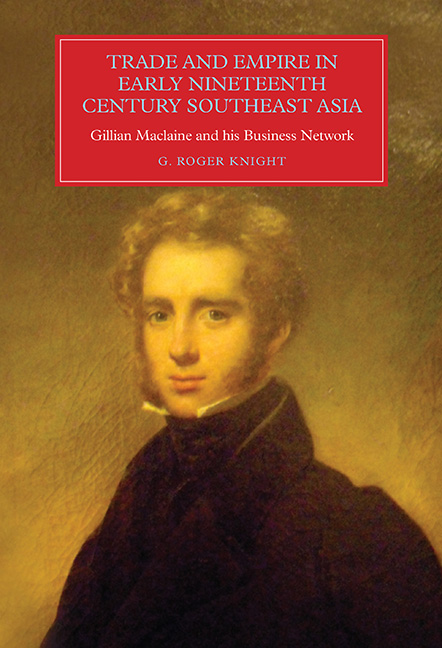 Trade and Empire in Early Nineteenth-Century Southeast Asia
Trade and Empire in Early Nineteenth-Century Southeast Asia Book contents
- Frontmatter
- Contents
- Acknowledgements
- Abbreviations
- Map of Maritime Asia: Trade and Empire, c. 1830
- Preface
- Map of South Central Java, c. 1830
- 1 Introduction: A Scots Émigré, Imperial Systems and Global Commodities
- 2 Maclaine’s ‘Apprenticeship’: The City of London and the Cotton Trade with Asia, 1816–20
- 3 A ‘Scotch Adventurer’: Batavia, Coffee and Colonial Wars, 1820–27
- 4 The Pivotal Years: ‘Maclaine Watson’, Treacherous Chains, Sickness and Debt, 1827–32
- 5 The Network Takes Shape: Connections, Business and Associates, 1832–40
- 6 Conclusion: Maclaine’s Legacy, Commodities and Trade on a Colonial ‘Periphery’, 1840–1964
- Bibliography
- Index
- Worlds of the East India Company
3 - A ‘Scotch Adventurer’: Batavia, Coffee and Colonial Wars, 1820–27
Published online by Cambridge University Press: 17 June 2021
- Frontmatter
- Contents
- Acknowledgements
- Abbreviations
- Map of Maritime Asia: Trade and Empire, c. 1830
- Preface
- Map of South Central Java, c. 1830
- 1 Introduction: A Scots Émigré, Imperial Systems and Global Commodities
- 2 Maclaine’s ‘Apprenticeship’: The City of London and the Cotton Trade with Asia, 1816–20
- 3 A ‘Scotch Adventurer’: Batavia, Coffee and Colonial Wars, 1820–27
- 4 The Pivotal Years: ‘Maclaine Watson’, Treacherous Chains, Sickness and Debt, 1827–32
- 5 The Network Takes Shape: Connections, Business and Associates, 1832–40
- 6 Conclusion: Maclaine’s Legacy, Commodities and Trade on a Colonial ‘Periphery’, 1840–1964
- Bibliography
- Index
- Worlds of the East India Company
Summary
This is really a strange world and I little thought when I left England of settling in Java, much less of ever being a Coffee Planter or a tenant of the Emperor of Solo. A Scotch Adventurer however must pay his account to many vicissitudes in life.
It is improbable nonetheless that Maclaine could have anticipated what was actually in store for him. Between 1820 and 1827 he first dallied with the idea of setting up as a merchant in Batavia and then established himself as a deeply impecunious coffee-planter in the mountains of central Java. Subsequent to that, his investment there was placed in jeopardy by the hostility of the Indies government and threatened with destruction in a major colonial war. Moreover, as if that were not enough, he had to contend with commercial hazards that had to do, among other things, with a very significant curtailment of the import of British cottons into Java, with the rapacity of his overseas partners and with the spectacular default of a key associate on Java itself.
Maclaine arrived in Batavia in July 1820 aboard the ship Mary Anne, together (as we have just seen) with a cargo of cotton piece goods dispatched by the East India house for whom he had been working in London. Founded in its colonial form by the VOC early in the seventeenth century, Batavia was at one time an essentially Chinese city flying a Dutch flag. When Maclaine arrived there, it had long ceased to be that, but was still a city with a large and commercially dominant Indies-Chinese (in modern parlance, Chinese- Indonesian) minority made up both of recent arrivals and of families who had been long settled there. It was merchants from this group of Batavia's ethnically and culturally very mixed population with whom most of the recently arrived Maclaine's business dealings took place. Maclaine also found himself, however, among a small community of European merchants, the majority of them British – a legacy (as we have seen in an earlier chapter) of the British occupation of the island from 1811 until 1816 by East India Company forces during the later stages of the Napoleonic Wars.
- Type
- Chapter
- Information
- Trade and Empire in Early Nineteenth-Century Southeast AsiaGillian Maclaine and his Business Network, pp. 57 - 92Publisher: Boydell & BrewerPrint publication year: 2015


